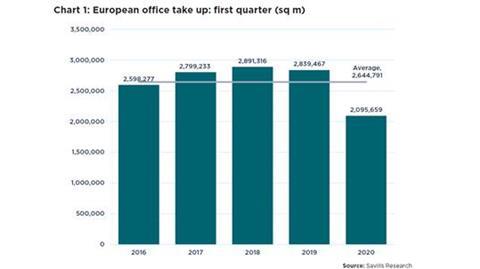The European office market is starting to slow despite a positive start to 2020, according to Savills Spring 2020 European Office Outlook.

Data from the international real estate advisor shows that, as many countries start to come out of a period of lockdown due to the Coronavirus pandemic, the shape of recovery and prospects for a swift economic revival have shifted with many predicting a “U” shaped recovery.
Take-up remains below average
Most government lockdowns across Europe were not fully implemented until March, which has limited the completion of some deals before the end of Q1. Figures from the report show that take-up across European offices reached 2.1 million m2 in Q1 2020, 21% below the five-year average.
This can largely be attributed to lower take-up levels in the larger cities of Paris Ile-de-France (-37% year-on-year), Berlin (-33% y-o-y), and Madrid (-47% y-o-y), though it is important to remember that this figure is often influenced by deals completed during Q4 of the previous year.
As such, it is expected that Q2 2020 will bear the brunt of the impact the coronavirus pandemic has had on the office leasing sector across Europe, with many viewings postponed and surveyors unable to undergo technical due diligence on properties.
What does this mean for rents?
Although the nature of each economic downturn depends on the status of the economy in that given moment, looking back to the Global Financial Crisis (GFC) can help give an indication of how resilient the office market is during these periods of uncertainty.
Analysis of core European markets during the GFC indicates that vacancy rates rose from 7.9% to 9.6% which subsequently reduced prime rents by an average of 18% from the 2007 peak to the 2009 trough. ‘Our analysis clearly shows that the c.9% vacancy rate level is an accurate indication for stable office rents across the core cities,’ said Jeremy Bates, head of Worldwide Occupier Services, Savills.
‘Nevertheless, we feel it is unlikely that prime rents will decline to the same extent that they did during the GFC thanks to supply/demand fundamentals being on the side of the landlord and also thanks to government-backed initiatives to prevent job losses on the same scale.’
Capital markets: will core become ultra-core?
Similar to the unpredictability that surrounds the leasing market, forecasts for investment into European offices hinge somewhat on what fruits Q2 will bear. Q1, as expected, generated a robust start to the year with investment transactions reaching €23.3 bn – 16% above the five-year average of €20.1 bn. Much of this activity can be attributed to a shift back to core, illustrated by the resilience of the UK, France and Germany, accounting for a combined 73% of total transactions, up from 63% in Q1 2019. These countries were beneficiaries of €4.6 bn, €4.9 bn and €7.4 bn respectively, with the UK boasting an uptick of 60% y-o-y thanks to a clearer position around a Brexit strategy.
Mike Barnes, an associate in the European research division at Savills, added: ‘The flight to core markets is a theme we expect to gather pace over the course of this year as markets adjust to uncertainty. That said, the weight of office transactions we have experienced in recent years, will mean that investor sensitivity to pricing will increase as new buying opportunities emerge.
‘As part of a shift to core, we expect the proportion of cross border activity to decline compared to previous years, particularly from Asia-Pacific capital where we have observed unprecedented levels of investment in recent years. We expect that this will affect the Southern European and Central and Eastern European (CEE) markets which are more heavily dependent on cross border capital, relatively more than those in Western Europe.’










